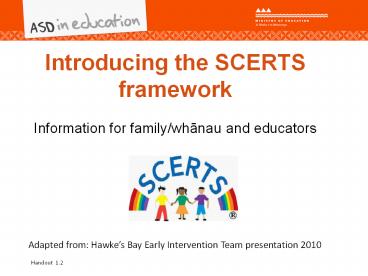Introducing the SCERTS framework - PowerPoint PPT Presentation
Title:
Introducing the SCERTS framework
Description:
S C E R T S a framework for working with children with autism spectrum disorder * SCERTS communication ... and educators who are working with a young child ... – PowerPoint PPT presentation
Number of Views:531
Avg rating:3.0/5.0
Title: Introducing the SCERTS framework
1
Introducing the SCERTSframework
- Information for family/whanau and educators
Adapted from Hawkes Bay Early Intervention Team
presentation 2010
Handout 1.2
2
Objectives of presentation
- To understand why we have chosen the SCERTS
framework - To introduce the key elements of the SCERTS
framework - To show how the SCERTS framework links with ASD
and Te Whariki - AND
- Working together as a team
3
Autism spectrum disorder (ASD)
- Children with a diagnosis of ASD have delays or
difficulties in - the development of communication
- the development of social relationships
- play and imagination
- Many young children with ASD under- or over-react
to sensory information
4
SCERTS
- Is an assessment and programming framework for
children with autism and/or developmental needs. - Acknowledges that most learning during childhood
takes place in the social context of daily
activities and experiences - therefore
everyday, natural routines in the home and early
childhood setting are used - Acknowledges that caregivers and familiar adults
play an important part in supporting the childs
learning.
5
S C E R T Sa framework for working with children
with autism spectrum disorder
- Social
- Communication
- Emotional
- Regulation
- Transactional
- Supports
6
SCERTS communication stages
- The assessment is based on the child's
communication stage - Social Partner the child may or may not
communicate intentionally using gestures and
vocalisations - Language Partner the child is communicating
using words, gestures and/or symbols - Conversational Partner the child uses words,
phrases and sentences. They are learning about
conversations
7
SCERTSSocial Communication
- The goal for all children is to become competent
and confident communicators so they can be part
of social activities and learning - Children who communicate effectively have more
opportunities for play and learning and are more
able to enjoy social relationships
8
Social Communication
- Goals are targeted in
- Joint Attention
- The ability to share attention,
- emotion and intention with others
- Symbol Use
- The ability to understand and use
- objects, pictures, words or signs
9
SCERTSEmotional Regulation
- the ability to attend to, process and filter
environmental and sensory information - the ability to stay focussed, engaged and being
able to adapt to different situations - When children are emotionally well regulated they
are ready and available for learning
10
Emotional Regulation
- Mutual regulation
- the childs ability
- to respond to others using strategies
- to help them regulate
- Self regulation
- strategies used by the child to self
- regulate
11
SCERTSTransactional Support
- the planned supports and strategies that are
used to help the child participate and learn - the supports and strategies are used when working
on the childs goals in Social Communication
and Emotional Regulation - support to families and to the team
- Transactional supports are often referred to as
- the adult goals
12
Transactional Support includes
- Interpersonal Support - the strategies used by
adults when interacting with the child e.g.,
using gesture - Learning Support the environment, routines and
activities are structured to encourage social
communication and emotional regulation, e.g.
modifying an activity to ensure success for the
child
13
Interpersonal support
- An adult partner needs to
- be responsive
- - notice and respond to childs attempts to
communicate - foster initiation
- - offer choices
- set the stage for engagement
- - be at the childs level
- adjust the amount of language used
- - use simple sentences
- model appropriate behaviour
14
Learning supports
- Structured activities e.g. clear beginning and
end to the activity - Visual supports - to organise the day
- Using motivating toys and activities
- Adjustments to activities so that the child has
success
15
How SCERTS fits with Te Whariki principles
- Te Whariki principles
- SCERTS framework
- Whakamana
- Empowerment
- Nga Hononga
- Relationships
- Whanau Tangata
- Family Community
- Kotahitanga
- Holistic Development
- Social Communication and Emotional Regulation
- Transactional Supports
- Family and Community provide context for learning
- All domains of development are interrelated
16
The team can use SCERTS to
- assess the childs strengths and needs in the
areas that children with ASD have most
difficulty - set goals for the child in social communication
and emotional regulation for home and the early
childhood setting - plan activities that are meaningful and
purposeful, at home and at the early childhood
setting - provide a balance of free play and structured
activities. - identify the transaction support the
communication partner will use (the adult goals) - monitor a childs progress
- ensure that we share successes and challenges
and support each other
17
References
- Prizant, B. M., Wetherby, E. R., Laurent, A. C.,
Rydell, P. J. (2006). The SCERTS Model A
comprehensive educational approach for children
with autism spectrum disorders (Volume 1)
Assessment. Paul H. Brookes Publishing Co
Baltimore, USA. - http//www.asdineducation.org.nz































